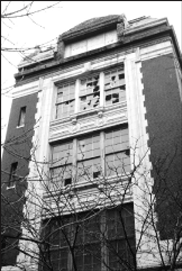By Albert Amateau
A State Supreme Court justice two weeks ago dismissed the $100 million lawsuit that developer Gregg Singer brought against the city in 2006 regarding the old P.S. 64 on E. Ninth St., which Singer bought from the city 10 years ago.
On Dec. 5, Manhattan Supreme Court Justice Paul G. Feinman granted the city’s motion to dismiss Singer’s suit that claimed that the Department of Buildings, the Board of Standards and Appeals and the Landmarks Preservation Commission all conspired to prevent Singer from obtaining a permit to build a 19-story dormitory on the site of the decommissioned five-story school building.
It was the third time this year that the developer lost a court case regarding the building designated in 2006 as a city landmark.
While the city Law Department issued a statement saying the decision marks the end of years of litigation, at least one East Village activist who has opposed Singer was not so sure.
“To quote my favorite philosopher, Yogi Berra, ‘It ain’t over till it’s over.’ I hope Singer feels he has taken it as far as it can go, but he still has legal recourse,” said Roland Legiardi-Laura, an East Village preservation advocate.
A telephone request to the developer for comment went unanswered earlier this week.
Singer bought the building between Avenues B and C from the city for $3.15 million in a public auction in 1998 with a restriction that it be used as a community facility. The old school had been serving as a local community and cultural center known as CHARAS/El Bohio, and local elected officials and neighborhood groups opposed the sale.
CHARAS had occupied the building 22 years, but Singer succeeded in evicting the group at the end of 2001.
In 2004 the developer proposed to build a 19-story dormitory on the site while retaining part of the old building. But the Department of Buildings ruled that to qualify for 19 stories under the community-facilities zoning allowance, instead of the 10 stories allowed for a simple residential development, Singer would have to prove the building was affiliated with one or more schools.
Singer appealed the ruling to the Board of Standards and Appeals, which upheld the Department of Buildings. The developer then challenged the B.S.A. in a suit in State Supreme Court, which upheld the decision that Singer had to prove a school affiliation to build his dorm project.
Singer next went to the Appellate Division, where he won a ruling that overturned the three previous decisions. But the city appealed to the New York State Court of Appeals, the state’s highest court.
Singer claimed he did not need to show affiliation with a school until after the project was completed.
Earlier this year, on March 25, the seven-judge Court of Appeals unanimously reversed the Appellate Division and upheld Buildings and B.S.A. The court opinion said: “It would create needless problems if the developer built a 19-story building only to find that he could not use it in a legally permitted way. The city would then face a choice between waiving the legal restrictions and requiring the building to remain vacant or to be torn down.”
Back in June 2006, the Landmarks Preservation Commission designated the old P.S. 64 as a city landmark, protecting it from demolition. But that August, the developer knocked decorative elements off the facade of the 1908 building under a Buildings permit that he had obtained prior to the landmark designation. Singer then went again to State Supreme Court to overturn landmark protection on the grounds that the removal of the facade elements made the building ineligible for designation.
Last month, State Supreme Court Justice Shirley Werner Kornreich determined that the deliberate removal of architectural details on the century-old building’s facade did not undermine the structure’s architectural significance or its historic and cultural associations, and she dismissed Singer’s suit.
In the ruling earlier this month, Judge Feinman, citing the March Court of Appeals decision and the November State Supreme Court decision, disallowed Singer’s claim that his constitutional rights to due process were violated. Feinman also dismissed allegations that Mayor Mike Bloomberg and then-City Councilmember Margarita Lopez and her successor, Rosie Mendez, conspired to deprive him of the profitable use of the property.
Commenting on Judge Feinman’s dismissal of the third suit, Virginia Waters, senior counsel of the city Law Department who handled the three cases, said, “The dismissal of all three cases vindicates the actions of the city agencies involved. These decisions should be a lesson to building owners that they cannot try and evade the mandates of the law by not complying with valid city requirements or by stripping a building of architectural detail.”
Michael Rosen, a neighbor and founder of the East Village Community Coalition, recalled the outrage of neighbors back in 1998 when then-Mayor Rudolph Giuliani put the building, which had then still been actively serving as the CHARAS/El Bohio cultural center, on the auction block.
“My organization worked for three years to secure landmarks designation for the building,” Rosen said on Tuesday. “I’m glad that Landmarks finally did it but it was an enormous expense of effort.
“I’d like to see the building returned to the community — as a public resource — from which it was stolen by the Giuliani administration,” Rosen added.
“I’ve always believed Singer’s three lawsuits were profoundly baseless,” he said. “We lost one on a split decision at the Appellate Division level, which we won at the Court of Appeals,” Rosen said. “We’re never going to give up. Even if the developer takes the two State Supreme Court decisions to a higher level, we’ll win.”




































